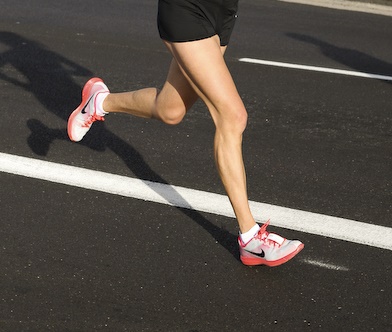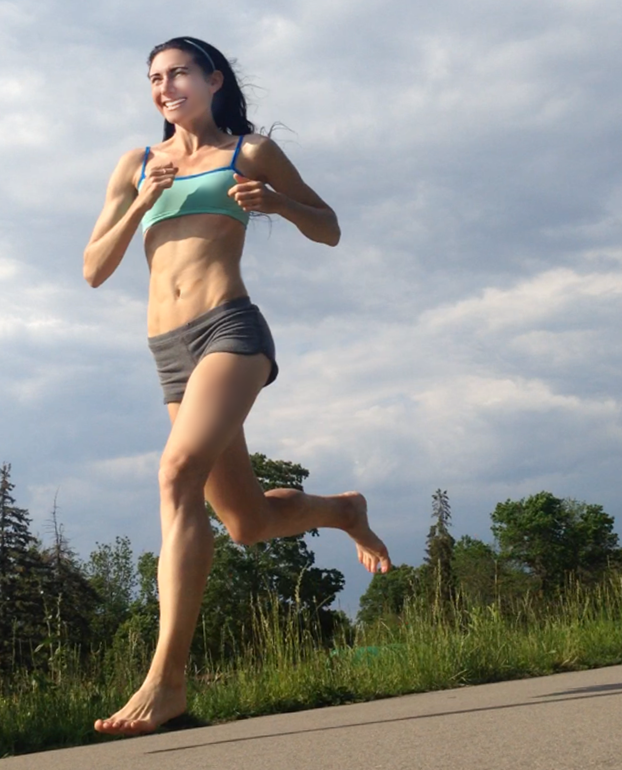Running on concrete has a bad rap because its commonly perceived to be hard on the legs, especially the knees and its believed that running on the roads, time and time again, may lead to persistent bouts of common running-related injuries, like shin splints and even bone fractures of the foot and leg. This is actually a BIG misconception in that it’s NOT the surface-type you run on that determines injurious impact forces, rather HOW you land on your foot and what you wear on your feet when you run.
Cushioned running shoes are supposed to reduce the blunt force of heel strike running, but for added protection, a runner must also naturally adjust their leg stiffness and flexion at the knee to further reduce impact. However, this is not seen in heel strike runners who wear cushioned running shoes, especially when running on concrete.

Is Running on Concrete Bad
No matter how much cushioning you have under your feet, if you heel strike when you run, you are going to generate a very harmful force called the heel strike transient. This force is so strong in magnitude that it penetrates through even the thickest cushioned running shoe. The human body also has its own impact reducing mechanisms that occurs at the reflexive level –controlled by the spinal cord. Part of this is mediated by the nerves in the feet whereby running barefoot seems the best way to activate these reflexes to avoid high impact landings and injury.
- Running barefoot hyper-activates neural pathways that lead from the bottoms of the sole of the feet to the spinal cord and brain areas responsible for processing sensory information from the ground. As a result, there is an increased activation of the spinal-leg withdrawal reflexes that prevents high impact landing behavior –this is how barefoot runners naturally and reflexively learn to run with safer, softer, lighter landing patterns as compared with most runners who wear running shoes with thick under-heel cushioning.

- The body’s senses become more aware when running barefoot on pavement in that the body has a greater propensity to avoid high impact landings by avoiding heel strike, and instead prompts a forefoot landing with greater knee flexion.
So, why run on a pavement, barefoot? A harder running surface seems to be the perfect substrate for prompting multi-sensory processing and integration in the feet and the spinal cord, and can only be optimized in the absence of cushioned shoes.
Studies have shown that when runners run barefoot or in barefoot-like shoes, they naturally switch from a heel strike to a forefoot strike landing pattern (Paquette et al, 2013). These runners also increase their leg stiffness on softer surfaces, and increase their leg flexion, particularly at the knee, on harder surfaces. All this is to reduce the duration of overloading that causes problems, such as bone microfractures and osteoarthritis (Robbins and Gouw, 1999).
When barefoot, sensory performances are unimpaired, which is why barefoot runners land with less impact, especially on hard surfaces, as compared with shod runners. Sensory performance is impaired when a cushioned running shoe is worn during running because the high-level sensory features in the feet are blocked. One study found that heel strike runners who wore cushioned running shoes did not change their foot strike to that of a lesser impact-foot strike when running on a hard surface (Fu et al. 2015), suggesting that differences in processing sensory information occurs between running in shoes and running barefoot.
The take home message is that runners run harder on pavement in cushioned running shoes because the sensory nerves in the feet are disconnected from the ground, and as a result, fails to help the brain construct a healthy perception of how their feet are interacting with the ground. Failing to build an accurate perception of foot strike awareness during running results in reflexive deficits, making it difficult to execute proper foot strike patterns. Therefore, there’s no adaptive benefit to running in shoes because the body does not learn to land with less impact.
Need more convincing on the dangers of cushioned running shoes? I have some solid insight as to why running shoes are so bad for runners. I also share advice on the health benefits of running without shoes.
References:
Fu et al. Surface effects on in-shoe plantar pressure and tibial impact during running. J Sport Health Sci, 2015; 4, 384-390.
Paquette MR, Zhang S, Baumgartner LD. Acute effects of barefoot, minimal shoes and running shoes on lower limb mechanics in rear and forefoot strike runners. Footwear Sci 2013;5:9–18.
Bretta Riches
BSc Neurobiology; MSc Biomechanics candidate, ultra minimalist runner & founder of RunForefoot. I was a heel striker, always injured. I was inspired by the great Tirunesh Dibaba to try forefoot running. Now, I'm injury free. This is why I launched Run Forefoot, to advocate the health & performance benefits of forefoot running and to raise awareness on the dangers of heel striking, because the world needs to know.
Latest posts by Bretta Riches (see all)
- Can You Run In Barefoot Shoes? Yes, But DON’T Heel Strike! - 21/07/2024
- Why Cushioned Running Shoes Are Really Bad for Your Feet - 19/07/2024
- Do Cushioned Running Shoes Cause Injuries? - 17/07/2024
